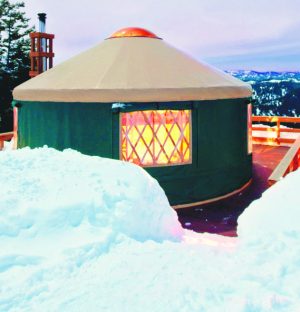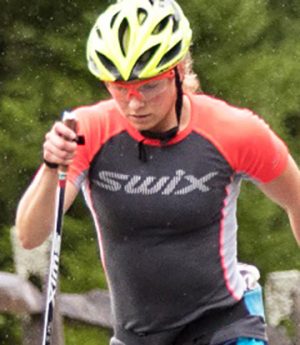To not be afraid of the big goal, the big dream; to not be afraid to try new things, to set new limits. I let hope be my guide, not fear,” Beckie begins. “I remember when Steiner (Mundahl, former Canadian National Team coach) retired from our team in ’98. He told me North Americans will never be successful because there’s no system behind them like the Norwegians have. At that time, Justin (Wadsworth) was a great influence. When I told him this, he said, ‘When you get to the start line, it’s not the system that carries you around the course. It’s you. It’s all you. At the start line, nobody is any different than you. It’s what you put into it.’ That was the best advice I ever got.”
![“Ski Rodeo” The racer in the Italian suit might be looking back. That doesn’t mean you have to, too. [P] www.seanmccabestudio.com](http://skitrax.com/wp-content/uploads/2010/03/ski_rodeo_image.jpg)
From the golden breakthrough in Salt Lake, let’s go back four years to the Nagano Olympics.
Beckie Scott: 45th.
That’s right. Your best race in the Nagano Olympics was 45th. How do you go from 45th in one Olympics to a champion at the next? Was it just this process of working your way up, the big breakthrough the year before Salt Lake, then . . . ?
BS: Those were parts of it. Then there was the team. A group of people emerged from Nagano who went through this utterly disappointing experience — Sara [Renner], Milaine [Theriault], Yves [Bilodeau, then athlete, now head of Canada’s service team] and Dave [Woods, coach]. This core group came out of Nagano thinking, “Oh my god, we have to do better than that. This is not good.” And we were, as a team, committed to doing better.
The next question was “How do we do better?” This is when Dave took over. To his credit, Dave really kept the theme in mind that we have four years to get this right. As a team, we can’t do worse. As a team, we were unsuccessful. We just weren’t good. We were really poor, results-wise. Having some success was a personal mission, but it was also assisted tremendously by a change in direction, in professionalism and approach by our team as well.
![“The Storm” From “Oh my. This is not good,” to such great heights just four years later. I think there might be a story in there. [P] www.seanmccabestudio.com](http://skitrax.com/wp-content/uploads/2010/03/the_storm-296x444.jpg)
After Nagano, did you really have to look yourself in the mirror?
BS: Oh, yeah. I remember saying, “Things have to change.” This was good. This was a turning point. Not to say it was Easy Street from there on out. We still had years of two-steps-forward, one-step-back kind of progression. But again, that’s the whole thing about being committed to ongoing learning; you have to appreciate the positives and glean something out of the negatives.
From 1998 to 2002, we learned so much from Nagano about what we did wrong, about what we needed to do better. We were clueless in Japan. We had no idea how to go to an Olympics and get good results at the same time. We took everything that went wrong in Nagano and was bad in Nagano and turned it around into what went right and what was so good about Salt Lake.
After Nagano, after taking this hard look in the mirror, you became highly focused.
BS: Yes. You noticed [laughs]. At first, Terry Orlick really helped me tune into this.
Dr. Orlick talks about the need to focus completely. What does this mean to you, to focus completely?
BS: As an athlete, to take in every kind of element, every component that it takes to be successful and giving it your fullest attention. To focus completely means to look into every detail and get everything out of myself that I could.
This was a shift in perspective, too. I had to work on focusing on the positive lessons, to get the positives out of a negative situation. Learning how to view things in a positive was a switch I had to make in those situations when it easily could have gone the other way.
How would you refocus, turning a negative into a positive?
BS: Here’s an example. I remember doing intervals and Yves was skiing on the backs of my skis. Over and over, he kept clipping my tails. It was getting really annoying. I was getting super-irritated with this. Then I was like, “In a mass-start race, there’s 60 women who’ll be skiing on the backs of my skis. This is a great chance to practise this.” This is how I got something positive out of this annoyance.
Dr. Orlick also talks about the simple joys.
BS: [Big laugh] Oh you’re good. You’ve been doing your homework.
No matter if it’s a small thing or if they take up a small part of your day, you need to have one or two or three simple joys, daily. What are some of simple joys?
BS: When I was racing and not on the road, it was being home with Justin and spending the time we could together — the young married couple. And our golden retriever, Henna. That, to me, was the greatest simple joy ever — taking Henna for a walk. There’s nothing like a dog to remind you how fun it is to get outside, see the neighbourhood and go for a walk. Henna is a great reminder of the simple joys of life.
What was going on in your mind on race day? You seem a pretty excited, energized person.
BS: To be as successful as I could, this has always been at the forefront of my thoughts. To overcome any obstacles or adversities that represented themselves as distractions, you know — to be able to refocus and stay in the game. On race day, it’s always the same, which is to take the opportunity I had that day, that moment, to use it and go for it.
What were you able to tap into on those special days? You have many solid races. You also had those special ones as well.
BS: Yes, I did. It’s hard to say. At Salt Lake, there was unbelievable energy from the crowd. They really sensed that this was happening, or was about to happen — a medal could go to a country that had never won one before in cross-country skiing. Everybody’s screaming, this support from the crowd totally uplifted me in a way I never had in a race before. This just propelled me to the finish, along with a fierce determination to fight all the way to the bitter end, to give everything I could to get what I wanted. It’s an almost indescribable feeling to have nothing left at the end, and know that I did everything in my power to be as successful as I could.
Was the Salt Lake Olympic pursuit your greatest race? Mind taking us back there?
BS: Yes, my greatest one would be the one everyone would think — the gold-medal race. I didn’t really know it would be possible to win an Olympic medal. And it really did come down to the final lunge across the finish line for a medal versus fourth place, which, ultimately, would be first, but under the circumstances would have been an entirely different experience. The first medal for Canada . . . just an extraordinary day, a day I still remember vividly.
You went into the Olympic double pursuit with the idea that you had to put yourself in position on the classic portion. Then, if you did that, you could hang in on the skate leg and execute your game plan over the last kilometre and a half.
BS: More or less. I had a strategy for the first five kilometres as well. I had everything I wanted to do planned out beforehand. I felt good in training. The conditions were great. I was feeling positive about everything. I had one race already at the Olympics, the 10 kilometre that went well. I was over the whole first -race-at-the-Olympics nerves. After the 10 kilometre went well — I think I finished sixth — I knew I was really set up well for the pursuit. I also knew how the women were going to race on the course; how the pack comes together on the downhills and, most importantly, how the last hill [Hermod’s] is the make-it-or-break-it climb. People didn’t really make moves until then. If I could hang in until that climb and have enough energy to get up that hill as fast as the leaders, I would be in there, I’d do very well.
If there’s one race you could do over, do differently, which would it be?
BS: The Olympic sprint from Salt Lake. I could have medaled there.
You finished fifth, winning the B Final?
BS: Right. I just made tactical errors. In sprinting, it always seems to come down to the small things — this is what makes sprint such a great progression for the sport.
What was the tactical mistake?
BS: I don’t remember exactly, the races were going out slowly. I let a competitor in on a corner I shouldn’t have. That’s not the point I want to make.
The point is, I’d already won the pursuit medal. I didn’t reset my aspirations after this. I was still riding a kind of high from the medal. I didn’t go into the Olympic sprint as focused and as sharp as I should have. If I had, I would have another Olympic medal.
I remember you really dominating the B Final. You looked like a different racer in the B Final than the one I saw in the semi-final.
BS: Yes. To me, this was a golden missed opportunity that I really regret.
The summer before the 2002 Salt Lake City Winter Olympics, I remember you and Bente Skari training together all the time in and around Soldier Hollow. It seemed you were two rivals coming together, working together.
BS: Yes.
How did this come about?
BS: Basically I heard Bente was coming to Park City and I saw it as a golden opportunity to learn from the best. My whole approach to ski racing was “I have to learn as much as I can.” If that means training with the best, then, it’s a chance I cannot pass up.
I knew Bente from ski racing previously. I knew she was a really nice person, really easy to get along with. Training with Bente was not awkward. This was a welcome experience.
What should people take away from Bente’s career? She’s been out of the sport five or six years. But when she was racing World Cups and winning World Championship medals, she was one of the biggest in skiing. Bente seemed to approached skiing a certain way, and was such an open and approachable person without an air of ego that one might expect from such a champion.
BS: She was. After training with her and racing against her, the thing that stuck out was that Bente was the ultimate professional. It’s like she never let things slip or slide. Everything she did, she held to a very high standard, from Day One of the season to the last day of her career.
Bente never had excuses for poor performances. And she rarely had poor performances. That was what was so outstanding to me — that she would go to the start line and be virtually unbeatable every single time. This is incredible. It takes incredible mental energy as well as physical. Her approach was so concise and so close to perfection, day in and day out. The last year of her career, I think she won pretty much everything, except a couple at the Olympics that we knew the Russians were doping for anyway.
In an earlier interview I had with Alison Owen-Bradley, she said you and Bente were the two skiers of the last era who really stood out, that she felt approached skiing the right way. She liked watching the way you approached a race, the way you classic-skied. Did you ever know about Alison’s career?
BS: I knew a little bit, but not much. Just given the different countries, the generation gap, what I knew was she was an American successful on the international stage.
Who were some of your biggest rivals in racing?
BS: Anita Moen. Oh yeah. Yeah, definitely Anita. And Bente — no, I shouldn’t say Bente. By the time she retired, I was not really that competitive with her yet. I had my best years after she retired. And Marit Bjoergen obviously. We were fighting for the Overall World Cup Championship the last year of my career, when only a handful of points separated us. In the end, I’d say Marit was my biggest rival.
What can you tell us about Anita and Marit? What kind of characters were they? Anita, for one, seemed to possess a real strong personality.
BS: Anita taught me so much about how to race, particularly how to race sprints. I learned a lot from her style.
What was that style?
BS: Aggressive.
And?
BS: And take no prisoners. You know, just don’t let anyone get in your way. I was a little hesitant, always a little nervous what people would think off the track. I didn’t want to make any enemies. I was really timid. I got beat by her enough times when I shouldn’t have; beat purely because of her tactics and her strategy and aggression on the course. I realized I would be fourth forever if I didn’t start learning something from these experiences.
Beckie Scott is the first North American to win Olympic gold in cross-country skiing. At the 2002 Games in Salt Lake City, UT, Scott was first awarded the bronze medal in the women’s 10km pursuit. When the two skiers ahead of her were caught doping Scott pursued a two-year process that saw her awarded the silver and then the gold.






![National camp action [P]...](https://skitrax.com/wp-content/uploads/2019/08/Duluth-4-2019-08-08-at-10.46.51-AM-300x246.png)
![Matt Liebsch on the CXC Elite Team [P] CXC...](https://skitrax.com/wp-content/uploads/2019/08/Matt-Liebsch-CXC.2-525x700.4-300x267.jpg)
![Dan LaBlanc [P]...](https://skitrax.com/wp-content/uploads/2019/08/Dan-LaBlanc-img_1855.3.jpg)

![“Over the Edge” In Pursuit of Excellence, exhilarating. [P] www.seanmccabestudio.com](http://skitrax.com/wp-content/uploads/2010/03/over_the_edge-300x408.jpg)
![“Sun Mountain” The head is down, the effort high, the views great. [P] www.seanmccabestudio.com](http://skitrax.com/wp-content/uploads/2010/03/sun_mountain_image-300x400.jpg)
![[P] COC archives](http://skitrax.com/st2/wp-content/uploads/2010/01/Beckie_bottom-e1265760201834.jpg)